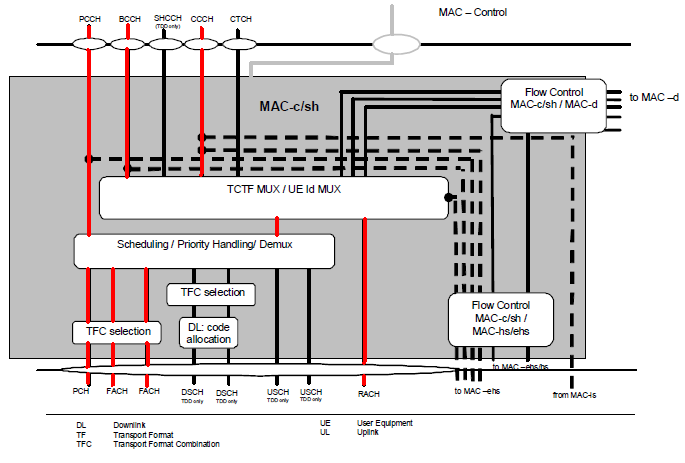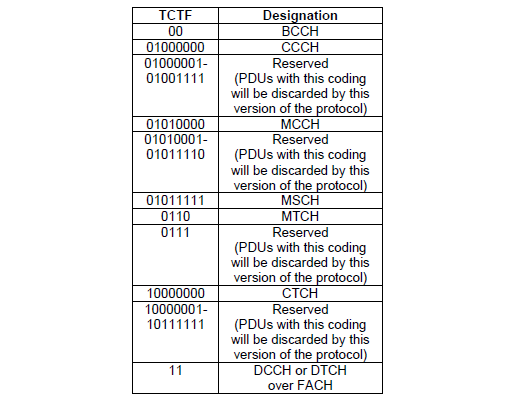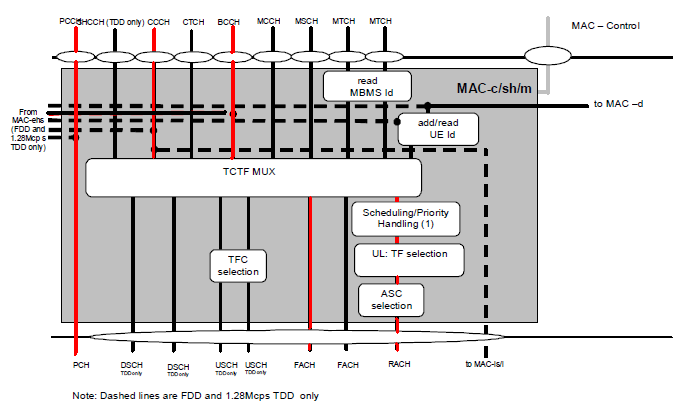|
3G/UMTS |
||
|
Channel Mapping : MAC-c/sh
< Overview on MAC-c/sh/m in UTRAN >
Now let's look into MAC-c/sh/m moudle in UTRAN MAC. It looks pretty complicated and intimidating ? Well... let's just pick what we are interested in for now as I suggested above.
Now.. I am only interested in FDD. TDD is not my interest now. CTCH (mainly for Cell Broadcasting) is not may interest either for now. With this focusing, we only have the path marked with red lines. Does this look simpler to you ? I hope you say "YES".
One thing you have to notice in this diagram is that the line does not have any arrow head. It does not mean that the line is always bidirection. Some line means uni-directional and some line means bi-directional. In this case, PCCH and BCCH are unidirectional, downlink only. CCCH is bidirectional which means both for downlink and uplink.
< 25.321 - Figure 4.2.4.1.1 : UTRAN side MAC architecture / MAC-c/sh/m details >
Another tip of understanding this diagram is to correlate this diagram to MAC PDU structure of each channel that is following this diagram (In 25.321, they are quite a far apart.. so you may lose mental connection between the two). The end result of most of the procedure shown in the above figure is adding or removing a special portions in MAC header.
The first path we are thinking of is PCCH path which is downlink only and carries Paging message (Paging Type 1). 25.321 9.2.1.3 MAC header for PCCH says "There is no MAC header for PCH". (The spec says PCH would have MAC-ehs when the PCH is mapped on HS-DSCH, but this does not happen in the MAC component being discussed in this section).
Next path is BCCH path which is downlink only and carries MIB and SIBs. It can create one of the following three cases, but the case produced by the MAC component shown in this section is Case a) which does not have any MAC header. I means that it is going through TCTF MUX block without any modification. (Refer to 25.321 9.2.1.2 MAC header for BCCH for case b) and case c).
< 25.321 - Figure 9.2.1.2.1 : MAC PDU formats for BCCH >
Even though PCCH, BCCH path does not have any MAC header in this process and MAC layer still do something for this channel. It is TFC (Transport format Combination) Selection. MAC-c/sh select a proper TFCI and pass it to transport layer and then the transport layer encode PCH, BCH data into PHY layer format.
Next Path is RACH to CCCH path (Uplink) and CCCH to FACH path (downlink). RRC Connection Request is going through RACH to CCCH path and RRC Connection Setup is going through CCCH to FACH path. This path is dealing with the following MAC PDU structure. In CCCH to FACH path, MAC-c/sh adds TCTF to MAC SDU. In RACH to CCCH path, MAC-c/sh check TCTF value and remove it and then distribute the SDU accordingly to higher layer.
< 25.321 - Figure 9.2.1.4-1 : MAC PDU formats for CCCH mapped to RACH/FACH >
Meaning of TCTF value is summarized as in the following two tables.
< 25.321 - Table 9.2.1.2 : Coding of the Target Channel Type Field on FACH for FDD >
< 25.321 - Table 9.2.1.4 : Coding of the Target Channel Type Field on RACH for FDD >
< Overview on MAC-c/sh/m in UE >
Following is MAC-c/sh/m for UE side, but analysis logic and most of the detailed information is same as in UTRAN. The only thing you have to be careful about is direction of the path. For example, in this case, PCCH path is from the bottom (PCH) to UP (PCCH). CCCH path is also 'FACH to CCCH' or 'CCCH to RACH' which is opposite direction of UTRAN case.
< 25.321 - Figure 4.2.3.1.1 : UE side MAC architecture / MAC-c/sh/m details >
|
||





